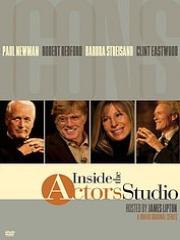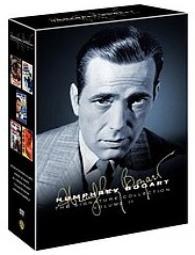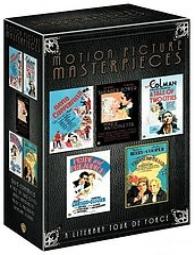
Knight at HOME at the Movies
Three Boxed Sets Suited for Fall Weather
As the chill creeps into the air and Daylight Savings Time takes effect, what could be more fitting than curling up with
some great classic movies and an interview set with three iconic movie stars?
As the chill creeps into the air and Daylight Savings Time takes effect, what could be more fitting than curling up with
some great classic movies and an interview set with three iconic movie stars?
The “masterpieces” in the title of Warner Home Video’s recently released boxed set
Motion Picture Masterpieces Collection refers to both the source material –
the novels these films were based on – and the movies themselves. The five titles
in question were all lavishly produced and released within a six year period during
MGM’s golden age and are grand entertainments, wonderful examples of epic
storytelling.
Treasure Island from 1934 is the first. MGM cannily teamed up the gruff Wallace
Berry and child star Jackie Cooper on many occasions (The Champ is perhaps the
best example of their films together). The Robert Louis Stevenson classic was The
Pirates of the Caribbean of its day (and has been remade several times with Disney's
version probably this ones only real competitor). Cooper is cast (with hair dyed
blonde) as Jim Hawkins, the young adolescent caught up in a search for buried
treasure and on the look out for the quintessential pirate baddie, Long John Silver
(essayed by Berry). The film was directed with the usual emphasis on storytelling by
Selznick’s director of choice, George Cukor, who had had a huge hit with another
classic screen adaptation of Little Women with Katharine Hepburn two years before.
Both David Copperfield and A Tale of Two Cities came from the pages of the Charles
Dickens classics and both were produced by David O. Selznick in the same year
(1935), who was then at the height of his MGM tenure. Selznick loved Dickens and
often carried around his own faded copy of “Copperfield” to find creative inspiration.
It’s the better of the two films with the perfectly cast Freddie Batholomew in the lead,
Edna Mae Oliver as the horse-faced but loving Aunt Betsey , Basil Rathbone as the
evil Uriah Heep, and of course, W.C. Fields as Mr. Micawber. This casting stroke of
genius was, of course, credited to Selznick. Whether that’s true or not the story of
the orphaned David and his various adventures is still an absolute delight. Much of
the same cast also appeared in the Jack Conway directed Two Cities which starred
Ronald Colman in the story of a man caught up in events surrounding the French
Revolution. The epic scope of the film is matched by its tender love story. These
two make for a, bracing and touching – though long – double feature.
Next up is the Norma Shearer version of Marie Antoinette from 1938. Shearer was the
undisputed queen of the MGM lot thanks to a string of hits produced by her
husband, the young genius Irving Thalberg. But Thalberg had died of a heart attack
in the midst of shooting what is one of the most lavish film productions of all time
and MGM immediately replaced the film’s original director, Reuben Mamoulian with
the much more efficient W.S. Van Dyke who was appropriately named “one take” for
his speed on the set. But even Van Dyke couldn’t shake Shearer from giving what
may be her best performance. The role of the insecure girl who becomes the
misunderstood French queen is given warmth and depth by Shearer. She is ably
supported by the sumptuous production, the beautiful Tyrone Power as her love
interest and the eccentric Robert Morley as her doddering husband, Louis the 14th.
Finally, the set concludes with 1940’s Pride & Prejudice with Greer Garson and
Laurence Olivier in the title roles in the Jane Austen classic. Both are too old for the
parts and neither ever seems to fully grasp their roles – Garson lacks the boldness
and sensuality, Olivier though handsome, never hints at the embers underneath.
But the supporting cast, and the patented “MGM look” help immensely. Those in
favor of today’s fealty to absolute accuracy in costuming and set design will have a
lot of trouble with the anachronisms evident here but all in all, this is a spritely,
enjoyable version.
Each of the discs contains vintage shorts and cartoons of the period in which the
films were released and are a welcome addition.
One of my favorite series on Bravo is “Inside the Actor’s Studio” (though I miss the
original episodes that ran without commercials and were thus 20 minutes longer)
which features iconic actors discussing their careers with host James Lipton. Lipton
may have the annoying habit of getting a little too sticky moon candy over some of
his guests but you can’t argue with his research and it’s thrilling to hear some of the
interesting, unexpected answers from these performers. Often, the last segment, in
which the personality being profiled is turned over to the theatre students of the
Actor’s Studios for questions, is the most enlightening and surprising. Shout! Factory
is releasing this Tuesday a 3-disc set of three of the series biggest names. Inside
the Actor’s Studios – Icons is an appropriate title when Streisand-Newman-
Redford and Eastwood are the subjects. All the episodes and given introductions
with after thoughts by Lipton.
These are fascinating, fun interviews, filled with terrific behind the scenes anecdotes
and the set is highly recommended. Another episode, however, with Dave
LaChappelle, being released separately, is emblematic of the problem now facing
the show. The comic is funny enough but much too new in the business to really
warrant the career overview treatment and all the talk of “craft” amongst the heavy
theatre folk seems out of place. All the Big Names, it seems, have sat across from
Lapine and other questionable guests like LaChappelle have been included in the
line-up. I’d like to see extended versions of the Streisand-Newman-Redford-
Eastwood shows and eagerly await (and hope for) the same treatment with other
Lipton guests (they range from Midler to Streep).
After the huge success of special editions of Casablanca and The Treasure of the Sierra
Madre, they've now been collected along with the previously released High Sierra and
They Live by Night by Warner Home Video into the Humphrey Bogart Signature
Collection - Volume One. But with a star of Bogart's magnitude, it's no surprise
that a second volume is being released simultaneously and naturally it's titled the
Humphrey Bogart Signature Collection - Volume Two. The crown jewel of
the set – The Maltese Falcon – is a big one. Warner’s has given it a three-disc special
edition treatment that offers the same fascinating, insightful documentaries that are
hallmarks of all their Signature Collection editions plus there's the nifty bonus of two
previous versions of the film (the 1936 Satan Met a Lady with Bette Davis is a lot of
fun). The film, set mostly in cramped hotel rooms and smoke filled offices, has
never looked or sounded better (go ahead and toss out your previous version). And
the movie itself is simply a pleasure, the true beginning of film noir. Bogie is
supported by the marvelous Mary Astor, hiccuping Sydney Greenstreet, the fey Peter
Lorre and Elisha Cook, Jr. and others. John Huston expertly wrote and directed this
1941 masterpiece, his first movie.
But the other four films in the 7-disc set, though lesser known, offer plenty of
thrilling entertainment as well. They include 1942’s Across the Pacific (in which Bogie
re-teamed with Astor), Action in the North Atlantic (1943), a WWII actioner, All Through
the Night (1942), an improbable Bogie comedy (!) in which he takes on the Nazi’s
and finally Passage to Marseille (1944), yet another attempt to recreate the thrilling
Cassablanca magic (this time transported to Devil’s Island). All the films are aided
by the inclusion of vintage shorts and cartoons. A must have set for Bogart fans and
an entertaining collection for those who like classic Hollywood movies. All in glorious
black and white.
Motion Picture Masterpieces Collection refers to both the source material –
the novels these films were based on – and the movies themselves. The five titles
in question were all lavishly produced and released within a six year period during
MGM’s golden age and are grand entertainments, wonderful examples of epic
storytelling.
Treasure Island from 1934 is the first. MGM cannily teamed up the gruff Wallace
Berry and child star Jackie Cooper on many occasions (The Champ is perhaps the
best example of their films together). The Robert Louis Stevenson classic was The
Pirates of the Caribbean of its day (and has been remade several times with Disney's
version probably this ones only real competitor). Cooper is cast (with hair dyed
blonde) as Jim Hawkins, the young adolescent caught up in a search for buried
treasure and on the look out for the quintessential pirate baddie, Long John Silver
(essayed by Berry). The film was directed with the usual emphasis on storytelling by
Selznick’s director of choice, George Cukor, who had had a huge hit with another
classic screen adaptation of Little Women with Katharine Hepburn two years before.
Both David Copperfield and A Tale of Two Cities came from the pages of the Charles
Dickens classics and both were produced by David O. Selznick in the same year
(1935), who was then at the height of his MGM tenure. Selznick loved Dickens and
often carried around his own faded copy of “Copperfield” to find creative inspiration.
It’s the better of the two films with the perfectly cast Freddie Batholomew in the lead,
Edna Mae Oliver as the horse-faced but loving Aunt Betsey , Basil Rathbone as the
evil Uriah Heep, and of course, W.C. Fields as Mr. Micawber. This casting stroke of
genius was, of course, credited to Selznick. Whether that’s true or not the story of
the orphaned David and his various adventures is still an absolute delight. Much of
the same cast also appeared in the Jack Conway directed Two Cities which starred
Ronald Colman in the story of a man caught up in events surrounding the French
Revolution. The epic scope of the film is matched by its tender love story. These
two make for a, bracing and touching – though long – double feature.
Next up is the Norma Shearer version of Marie Antoinette from 1938. Shearer was the
undisputed queen of the MGM lot thanks to a string of hits produced by her
husband, the young genius Irving Thalberg. But Thalberg had died of a heart attack
in the midst of shooting what is one of the most lavish film productions of all time
and MGM immediately replaced the film’s original director, Reuben Mamoulian with
the much more efficient W.S. Van Dyke who was appropriately named “one take” for
his speed on the set. But even Van Dyke couldn’t shake Shearer from giving what
may be her best performance. The role of the insecure girl who becomes the
misunderstood French queen is given warmth and depth by Shearer. She is ably
supported by the sumptuous production, the beautiful Tyrone Power as her love
interest and the eccentric Robert Morley as her doddering husband, Louis the 14th.
Finally, the set concludes with 1940’s Pride & Prejudice with Greer Garson and
Laurence Olivier in the title roles in the Jane Austen classic. Both are too old for the
parts and neither ever seems to fully grasp their roles – Garson lacks the boldness
and sensuality, Olivier though handsome, never hints at the embers underneath.
But the supporting cast, and the patented “MGM look” help immensely. Those in
favor of today’s fealty to absolute accuracy in costuming and set design will have a
lot of trouble with the anachronisms evident here but all in all, this is a spritely,
enjoyable version.
Each of the discs contains vintage shorts and cartoons of the period in which the
films were released and are a welcome addition.
One of my favorite series on Bravo is “Inside the Actor’s Studio” (though I miss the
original episodes that ran without commercials and were thus 20 minutes longer)
which features iconic actors discussing their careers with host James Lipton. Lipton
may have the annoying habit of getting a little too sticky moon candy over some of
his guests but you can’t argue with his research and it’s thrilling to hear some of the
interesting, unexpected answers from these performers. Often, the last segment, in
which the personality being profiled is turned over to the theatre students of the
Actor’s Studios for questions, is the most enlightening and surprising. Shout! Factory
is releasing this Tuesday a 3-disc set of three of the series biggest names. Inside
the Actor’s Studios – Icons is an appropriate title when Streisand-Newman-
Redford and Eastwood are the subjects. All the episodes and given introductions
with after thoughts by Lipton.
These are fascinating, fun interviews, filled with terrific behind the scenes anecdotes
and the set is highly recommended. Another episode, however, with Dave
LaChappelle, being released separately, is emblematic of the problem now facing
the show. The comic is funny enough but much too new in the business to really
warrant the career overview treatment and all the talk of “craft” amongst the heavy
theatre folk seems out of place. All the Big Names, it seems, have sat across from
Lapine and other questionable guests like LaChappelle have been included in the
line-up. I’d like to see extended versions of the Streisand-Newman-Redford-
Eastwood shows and eagerly await (and hope for) the same treatment with other
Lipton guests (they range from Midler to Streep).
After the huge success of special editions of Casablanca and The Treasure of the Sierra
Madre, they've now been collected along with the previously released High Sierra and
They Live by Night by Warner Home Video into the Humphrey Bogart Signature
Collection - Volume One. But with a star of Bogart's magnitude, it's no surprise
that a second volume is being released simultaneously and naturally it's titled the
Humphrey Bogart Signature Collection - Volume Two. The crown jewel of
the set – The Maltese Falcon – is a big one. Warner’s has given it a three-disc special
edition treatment that offers the same fascinating, insightful documentaries that are
hallmarks of all their Signature Collection editions plus there's the nifty bonus of two
previous versions of the film (the 1936 Satan Met a Lady with Bette Davis is a lot of
fun). The film, set mostly in cramped hotel rooms and smoke filled offices, has
never looked or sounded better (go ahead and toss out your previous version). And
the movie itself is simply a pleasure, the true beginning of film noir. Bogie is
supported by the marvelous Mary Astor, hiccuping Sydney Greenstreet, the fey Peter
Lorre and Elisha Cook, Jr. and others. John Huston expertly wrote and directed this
1941 masterpiece, his first movie.
But the other four films in the 7-disc set, though lesser known, offer plenty of
thrilling entertainment as well. They include 1942’s Across the Pacific (in which Bogie
re-teamed with Astor), Action in the North Atlantic (1943), a WWII actioner, All Through
the Night (1942), an improbable Bogie comedy (!) in which he takes on the Nazi’s
and finally Passage to Marseille (1944), yet another attempt to recreate the thrilling
Cassablanca magic (this time transported to Devil’s Island). All the films are aided
by the inclusion of vintage shorts and cartoons. A must have set for Bogart fans and
an entertaining collection for those who like classic Hollywood movies. All in glorious
black and white.



